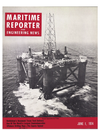
Page 31: of Maritime Reporter Magazine (June 1974)
Read this page in Pdf, Flash or Html5 edition of June 1974 Maritime Reporter Magazine
SKINNER TURBINES can consume about 40% less steam than other brands!
SNAME New England Section Hears Paper
On Flexible Membranes For Tankers
These American-made, single-stage, axial flow, re-entry type steam engines are available in four sizes from 1 to 1,500 hp. For continuous, intermittent or standby operation, they may be used horizontally or vertically for condensing or non-condensing service.
Rotation may be in either direction. A fail-safe system precludes the turbine from running without oil while a Woodward Governor prevents overspeeding.
REPLACEMENT UNITS have been supplied in the required time at approximately 2/3rds the cost of competitive overhaul. Size-wise, these units will fit in about 95% of existing U.S. and foreign cargo pump, fan and mechanical drives without radical change to the foundation.
SKINNER ENGINE COMPANY, a leader in the design and manufacture of marine engines for over a century, produces these precision-engineered turbines with rugged simplicity for long, trouble-free service.
We Cover the Waterfront m Every Hour of Every Day
Exclusive Marine Distributor for Skinner Turbines
HOFFERT-LOWE, INC. 1700 E. Church Street, Jacksonville, Florida 32202
Phone: 904/354-8242 • Telex: 5-6377 • Cable: Jaxameroid 348 Ridge Road, Lyndhurst, N.J. 07071 • 227 West 23rd Street, Norfolk, Va. 23517 212/571-0430 • • 804/622-9517 201/997-3332
Ashland Petroleum To
Double-Side Barges For
Environmental Safety
Ashland Petroleum Company, Ash- land, Ky., has begun the initial phase of a program to "double-side" most of its river barges to make them en- vironmentally safer.
Since most barges are constructed with single sides, the job requires ex- tensive rebuilding. The first phase involves 16 of Ashland's barges, some nearly the length of a football field.
Work on four is complete, with the balance of work scheduled for com- pletion at Delta Iron Works, Houma,
La., next year.
The jol>—'being conducted as part of regular barge maintenance—in- volves removing the original sides, and a portion of the deck and bottom plate. A prefabricated side section, consisting of the cargo tank wall and the outside shell, is then slid into position and welded into place. Three feet of air space separate the two sides, providing an extra margin of insulation and protection.
The barges now being rebuilt were recently recalled from crude oil serv- ice on the river when Ashland com- pleted its new pipeline from Owens- boro, Ky., to Ashland. The barges will also be fitted with heating coils to allow them to transport heavy fuel oil.
Ashland said the program will be extended to include a large number of other barges in its fleet.
Last year, the company purchased 41 new "double-skin" or double-hull barges which have been put in service transporting refined products to vari- ous river terminals.
Ashland said the double-siding pro- gram was not mandatory, but would simply provide a further margin of environmental safety on the river.
Ashland Petroleum is the largest operating division of Ashland Oil,
Inc.
A.G. 'Weser' Receives
Orders For Four 40,000-Ton Tankers
The A.G. "Weser" Bremerhaven
Yard has received orders for four 40,000-ton tankers (known as its "KEY 40" series), which will all be delivered by autumn 1976. Colo- cotronis Ltd., London, ordered two vessels, and Cosmos Shipping &
Trading Corporation, Monrovia, ordered two vessels.
The vessels have an approximate overall length of 633 feet, and a summer draft of about 38 feet.
The main engine, manufactured by Kreuzkopfmotor, with 13,800 bhp at 122 rpm, provides a speed of 15.8 knots.
Orders for 39 tankers have been received so far from both German and other foreign shipowners.
The "KEY 40" tankers can trade worldwide for the carriage of clean or dirty products.
A brochure describing the "KEY 40" can be obtained from the New
York office: "Weser" Shipyards,
Inc., One World Trade Center,
Suite 2841, New York, N.Y. 10048.
Cargo Pump Drive and Gear as supplied to National Bulk Carriers Pictured at tne SNAME New England Section meeting, left to right: Don Ridley, vice chairman; Dick Roberts, chairman; Prof. A. Douglas Carmichael, author; Mitch Steller,
General Dynamics Electric Boat Division; Steven Smith, also of Electric Boat, and Dr.
Rolf Glasfeldt of General Dynamics Quincy Division. Mr. Steller and Mr. Smith par- ticipated in the research reported in the paper, as graduate students at M.l.T. ible membrane system. Also During a recent meeting of the
New England Section of The So- ciety of Naval Architects and Ma- rine Engineers, members and guests heard a paper entitled "Pre- vention of Pollution through Iso- lation of Oil from Seawater Ballast in Tankers." The author, Prof.
A. Douglas Carmichael, was intro- duced by Keatinge Keays, after a social hour and dinner.
The work described was support- ed by the U.S. Navy and the U.S.
Coast Guard to study the feasibil- ity and economics of using a flex- ible, impermeable membrane to iso- late cargo oil from seawater ballast in the cargo tanks of tankers. The paper describes design, economic, and environmental aspects of a flex- membran o in- cluded is a discussion of tests done on a small scale cargo tank model with a flexible membrane installed.
In his presentation, Professor Car- michael used slides and a movie to illustrate the operation of the mod- el tank.
Professor Carmichael is profes- sor of power engineering in the ocean engineering department at the Massachusetts Institute of
Technology, where the research for the paper w.as done.
Copies of the paper may be ob- tained at a cost of $2 per copy by writing to: Robert Baseler, Editor,
New England Section, SNAME,
General Dynamics, Quincy, Mass. 02169. 32 Maritime Reporter/Engineerirtg News

 30
30

 32
32
